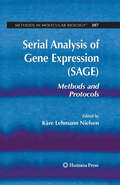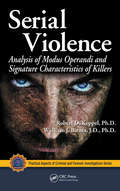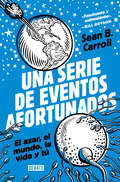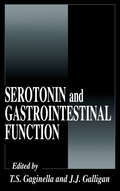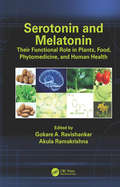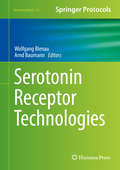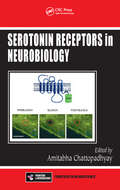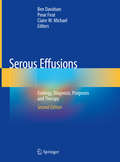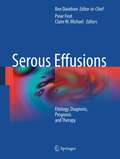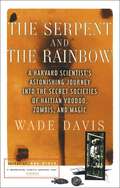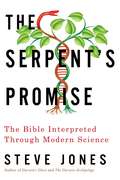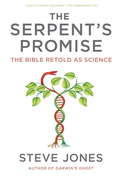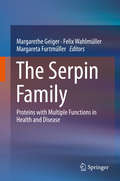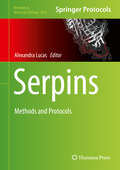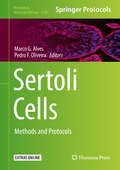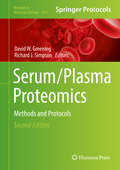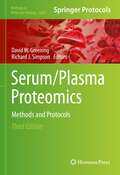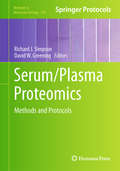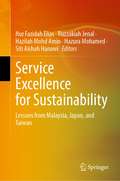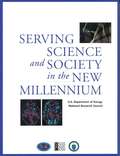- Table View
- List View
Serial Analysis of Gene Expression (SAGE)
by Kåre Lehmann NielsenThis book facilitates the introduction of SAGE into the laboratory and provides a framework for interpreting and comparing data derived from SAGE experiments. SAGE studies encompass 50,000 tags and can provide detailed knowledge of the 2000 most highly expressed genes in the tissue sample. The SAGE protocols presented are detailed, fully annotated, and tested, and are all written by experienced SAGE researchers from around the world.
The Serial Universe
by John William DunneIn this book I have tried to give the reader a bird's-eye view of the territory covered by the theory called 'Serialism'. Some of the chapters, greatly condensed, have been delivered in lecture form to the Royal College of Science (Mathematical Society and Physical Society). But the main outline of the subject is, I believe, clear enough to be appreciated by those who have no special technical knowledge. Where all is fog, a blind man with a stick is not entirely at a disadvantage. In my case, Fortune presented me with a stick; and I have used this with considerable temerity. Certainly, it has led me somewhere possibly only into the roadway, where I shall be run over by a motor-bus full of scientific critics. But, if I have crossed safely to the other side, then I should like to express my gratitude to Mr J. A. Lauwerys of the University of London, whose continuous encouragement has been the chief factor which has kept me tapping along.
Serial Violence: Analysis of Modus Operandi and Signature Characteristics of Killers (ISSN)
by Robert D. Keppel William J. BirnesLinking the murders of an alleged serial killer to successfully present a case in court involves a specific methodology that has been scrutinized by the judicial system but is largely absent in the current literature. Serial Violence: Analysis of Modus Operandi and Signature Characteristics of Killers fully explains the process of finding the nexus
Una serie de eventos afortunados: El azar, el mundo, la vida y tú
by Sean B. CarrollUna asombrosa exploración del azar como origen de toda la belleza y la diversidad del mundo. ¿Las cosas suceden por alguna razón o son fruto del azar? Filósofos y teólogos han reflexionado sobre esta cuestión durante milenios, pero no ha sido hasta hoy que los descubrimientos científicos la han resuelto: vivimos en un mundo donde impera la aleatoriedad. Como cualquier otra especie, los humanos estamos aquí por accidente. Pero ¿cuántas cosas tuvieron que ocurrir de cierta manera y no de otra para que existiéramos? Desde el impacto tremendamente improbable de un asteroide contra la Tierra hasta los cambios en su órbita durante la Edad de Hielo o las alteraciones invisibles en las gónadas de nuestros ancestros, somos producto de una asombrosa serie de eventos afortunados. Inspirado en figuras como Kurt Vonnegut y los Monty Python y escrito por uno de los mejores divulgadores científicos de la actualidad, este es el relato irresistiblemente entretenido y estimulante sobre uno de los aspectos más importantes y menos apreciados de la vida. Una asombrosa exploración del azar como origen de toda la belleza y la diversidad del mundo. La crítica ha dicho: «Fascinante y estimulante. Sean B. Carroll en todo su esplendor».Bill Bryson «Profundo, ingenioso y divertido. Cambiará para siempre la forma en la que te ves a ti mismo y al universo».Alice Roberts «Una visión breve, encantadora y científicamente sólida de la vida».Kirkus «Un libro sobre la historia de la humanidad contada con ingenio y estilo».John Brandon, Forbes «El papel de la casualidad en el destino del mundo puede parecer un asunto filosófico más que científico, pero Carroll, un biólogo, demuestra lo troncal que es esta idea en nuestro día a día».New York Times Book Review«En Carroll se combinan de forma singular tres rasgos de por sí singulares: un dominio de múltiples ámbitos científicos, una inigualable capacidad para explicar con claridad conceptos científicos complejos y un profundo instinto para contar historias».Barbara N. Horowitz, The Quarterly Review of Biology
Series of Bessel and Kummer-Type Functions (Lecture Notes in Mathematics #2207)
by Tibor K. Pogány Dragana Jankov Maširević Árpád BariczThis book is devoted to the study of certain integral representations for Neumann, Kapteyn, Schlömilch, Dini and Fourier series of Bessel and other special functions, such as Struve and von Lommel functions. The aim is also to find the coefficients of the Neumann and Kapteyn series, as well as closed-form expressions and summation formulas for the series of Bessel functions considered. Some integral representations are deduced using techniques from the theory of differential equations. The text is aimed at a mathematical audience, including graduate students and those in the scientific community who are interested in a new perspective on Fourier–Bessel series, and their manifold and polyvalent applications, mainly in general classical analysis, applied mathematics and mathematical physics.
A Series of Fortunate Events: Chance and the Making of the Planet, Life, and You
by Sean B. Carroll"Fascinating and exhilarating—Sean B. Carroll at his very best."—Bill Bryson, author of The Body: A Guide for OccupantsFrom acclaimed writer and biologist Sean B. Carroll, a rollicking, awe-inspiring story of the surprising power of chance in our lives and the worldWhy is the world the way it is? How did we get here? Does everything happen for a reason or are some things left to chance? Philosophers and theologians have pondered these questions for millennia, but startling scientific discoveries over the past half century are revealing that we live in a world driven by chance. A Series of Fortunate Events tells the story of the awesome power of chance and how it is the surprising source of all the beauty and diversity in the living world.Like every other species, we humans are here by accident. But it is shocking just how many things—any of which might never have occurred—had to happen in certain ways for any of us to exist. From an extremely improbable asteroid impact, to the wild gyrations of the Ice Age, to invisible accidents in our parents' gonads, we are all here through an astonishing series of fortunate events. And chance continues to reign every day over the razor-thin line between our life and death.This is a relatively small book about a really big idea. It is also a spirited tale. Drawing inspiration from Monty Python, Kurt Vonnegut, and other great thinkers, and crafted by one of today's most accomplished science storytellers, A Series of Fortunate Events is an irresistibly entertaining and thought-provoking account of one of the most important but least appreciated facts of life.
Serotonin and Gastrointestinal Function (Handbooks In Pharmacology And Toxicology Ser. #23)
by Timothy S. Gaginella James J. GalliganSerotonin and Gastrointestinal Function provides a comprehensive review of current research into the mechanisms by which serotonin acts on gastrointestinal tissues. This book covers neurochemistry, physiology, pharmacology, and clinical issues relevant to serotonin in the gastrointestinal tract. The editors have brought together the most relevant information from the molecular to the clinical level. Each chapter is written by investigators experienced in research on serotonin's actions in the gut. This book will be useful to basic scientists, clinical investigators, graduate and postgraduate students.
Serotonin and Melatonin: Their Functional Role in Plants, Food, Phytomedicine, and Human Health
by Gokare A. Ravishankar Akula RamakrishnaSerotonin and Melatonin: Their Functional Role in Plants, Food, Phytomedicine, and Human Health highlights the significance of the plant sources of serotonin and melatonin in the fields of medicine, agriculture, and food science. Over the last few decades, an enormous amount of research data has been generated on these two neurotransmitters/plant signalers. This book covers topics regarding the occurrence of serotonin and melatonin in medicinal plants and food value plants with their implications for human health, the role of serotonin and melatonin in plant growth development, functions of melatonin and serotonin in the environmental adaptation of plants, and the implications of these molecules in human disorders and treatments. This volume should appeal to scientists and other professionals engaged in basic and applied research on the relevance of serotonin and melatonin to plants, animals, and humans. Features Reviews the global scientific literature and the experimental data of the authors on the occurrence of serotonin and melatonin in medicinal and food value plants and its implications for human health Explains in detail the role of serotonin and melatonin in plant growth development Helps in understanding the complex functions of melatonin and serotonin in the environmental adaptation in plants Discusses the importance of the development of transgenic plants with high amounts of serotonin and melatonin. Describes the current understanding of serotonin and melatonin in human disorders, and also their relevance in the treatment of specific health conditions. Written by acknowledged experts from across the world
The Serotonin Power Diet
by Judith J. Wurtman Nina FrusztajerFood plan with various stages to it. Its intent is to keep serotonin levels in the body high. Contains recipes.
Serotonin Receptor Technologies
by Wolfgang Blenau Arnd BaumannReflecting a vast amount of new information concerning the functional characteristics of the various 5-HT receptor subtypes and the Na+-dependent serotonin transporter (SERT), this volume provides state of the art methodologies currently applied in serotonin research from leading experts in the field. Serotonin Receptor Technologies describes approaches that vary from molecular biological and biochemical techniques (e. g. , regarding receptor dimerization), fluorescence microscopy and imaging applications, flow cytometry, the use of organotypic slice and cell cultures to the generation of genetically modified animal models and the development of sophisticated behavioral tests, thus covering a wide spectrum of techniques to study serotonergic signaling in detail. Written for the popular Neuromethods series, chapters include the kind of detail and practical advice that ensures successful results in the lab. Authoritative and convenient, Serotonin Receptor Technologies serves to foster both basic and translational research aiming to further deepen our understanding of the various facets of aminergic systems, as well as to aid research on similar problems with related GPCRs and neurotransmitter transporters.
Serotonin Receptors in Neurobiology (Frontiers in Neuroscience)
by Amitabha ChattopadhyayA number of developments spanning a multitude of techniques makes this an exciting time for research in serotonin receptors. A comprehensive review of the subject from a multidisciplinary perspective, Serotonin Receptors in Neurobiology is among the first books to include information on serotonin receptor knockout studies. With contributions from l
Serous Effusions: Etiology, Diagnosis, Prognosis and Therapy
by Ben Davidson Pinar Firat Claire W. MichaelThis revised and updated second edition contains multiple microscopic illustrations of all diagnostic entities and ancillary techniques, providing a comprehensive, authoritative guide to all aspects of serous effusions. It now includes the many new antibodies which have been tested since the previous edition, as well as a discussion on next-generation sequencing and molecularly targeted therapy.Section one covers diagnosis for benign and malignant effusions while section two discusses biology, therapy, and prognosis highlighting clinical approaches that may be of value.Serous Effusions provides an indispensable guide to all aspects of current practice for cytopathologists, cytotechnicians, pathologists, clinicians and researchers in training and practice.
Serous Effusions
by Claire W. Michael Pinar Firat Ben DavidsonSerous (peritoneal, pleural and pericardial) effusions are a frequently encountered clinical finding in everyday medical practice and one of the most common specimen types submitted for cytological evaluation. The correct diagnosis of effusions is critical for patient management, as well as for prognostication and yet many clinicians find diagnosis and treatment of cancer cells in effusions very challenging. Featuring multiple microscopic illustrations of all diagnostic entities and ancillary techniques (immunhistochemistry and molecular methods), this book provides a comprehensive, authoritative guide to all aspects of serous effusions, including etiology, morphology and ancillary diagnostic methods, as well as data related to therapeutic approaches and prognostication. Section one covers diagnosis for benign and malignant effusions including the etiological reasons for the accumulation of effusions that provides the reader with the full spectrum of differential diagnoses at this anatomic site. Section Two discusses biology, therapy and prognosis highlighting clinical approaches that may be of value to patients and the movement towards personalized medicine and targeted therapy. Written by experts in the field internationally, Serous Effusions will provide an indispensible guide to all aspects of current practice for cytopathologists, cytotechnicians, pathologists, clinicians and researchers in training and practice.
The Serpent and the Rainbow: A Harvard Scientist's Astonishing Journey into the Secret Society of Haitian Voodoo Zombis and Magic
by Wade DavisA scientific investigation and personal adventure story about zombis and the voudoun culture of Haiti by a Harvard scientist.In April 1982, ethnobotanist Wade Davis arrived in Haiti to investigate two documented cases of zombis—people who had reappeared in Haitian society years after they had been officially declared dead and had been buried. Drawn into a netherworld of rituals and celebrations, Davis penetrated the vodoun mystique deeply enough to place zombification in its proper context within vodoun culture. In the course of his investigation, Davis came to realize that the story of vodoun is the history of Haiti—from the African origins of its people to the successful Haitian independence movement, down to the present day, where vodoun culture is, in effect, the government of Haiti’s countryside. The Serpent and the Rainbow combines anthropological investigation with a remarkable personal adventure to illuminate and finally explain a phenomenon that has long fascinated Americans.
The Serpent's Promise: The Bible Interpreted Through Modern Science
by Steve JonesFrom acclaimed geneticist Steve Jones, the story of the Bible as told through the lens of modern science. In The Serpent's Promise, Steve Jones retells many of the Biblical tales in the light of modern science. Are we all descended from a real-life Adam and Eve? Are some--or all--of us marked with the molecular equivalent of original sin, and if so what can we do about it? Was the Bible's great flood a memory of the end of the Ice Age? And what can science tell us of the mystical experiences reported by the faithful, or of the origin of faith itself? Some people deny the power of religious belief, others the findings of science. In this groundbreaking work from one of our great science writers, Steve Jones explores how these mysteries often overlap. He steps aside from the noisy debate between believers and non-believers to show how the questions that preoccupy us today are those of biblical times--and that science offers many of the answers. At once brilliantly erudite and highly readable, The Serpent's Promise is a witty and thoughtful account of the greatest scientific story ever told.
The Serpent's Promise
by Steve JonesA unique contribution to the God/religion debate: a scientific take on the Bible that doesn't take sides. Many of the subjects studied by physicists or by biologists are found in the texts of the world's religions: the origins of the universe, of life and of mankind; fate, sex, age and death; and the prospects of eternal life or of fiery doom. The Bible is a handbook for understanding Nature and, in its own way, it succeeds. As a factual account, of course, it is out of date, but many of its statements can be rephrased in modern terms. Distinguished geneticist Steve Jones has done that: written a rivetingly accessible work on recent advances in our understanding of ourselves, using the Bible as a framework. His narrative is structured around the Good Book's grand themes, from Genesis to Revelations, and weaves a series of unexpected facts into a coherent whole. The struggle of rationalism with its opposite has, after decades of torpor, returned to centre stage. Polemics against and in favour of religion and atheism fill the shelves. Instead of adding to that pile, Steve Jones stands back and take a fresh look at that issue in a volume that is not an attack or a defence but which explores scriptural motifs--Creation, the Garden of Eden, original sin, the Exodus, virgin birth, the Resurrection, and the Last Judgment--using the methods and results of the latest scientific research. It is a remarkably quick jump, shows Professor Jones, from Adam to astrophysics. Although some of the questions raised are beyond the capabilities of science, at least a scientist can ask them in a new way. Steve Jones shows there is a better route to understanding the universe than through doctrine.
The Serpin Family
by Margarethe Geiger Felix Wahlmüller Margareta FurtmüllerThe book provides an comprehensive overview on biology, genetics and cellular functions of serpins (serine protease inhibitors) in health and disease. With over 1000 members serpins are the most diverse family of protease inhibitors. Latest groundbreaking research findings are presented and broaden the understanding on inhibitory and non-inhibitory serpins, not only in mammalian organisms but also in insects, worms, plants and viruses.
Serpins: Methods and Protocols (Methods in Molecular Biology #1826)
by Alexandra LucasThis volume explores the latest methods used to study and define serpin molecular structure, basic protease inhibition, serpin targets, and the roles of serpin in biology and disease using animal models. The chapters in this book cover topics such as crystallography and phage display, peptide design, phospholipid binding, and thrombus formation to microbiome analysis and development. Written in the highly successful Methods in Molecular Biology series format, chapters include introductions to their respective topics, lists of the necessary materials and reagents, step-by-step, readily reproducible laboratory protocols, and tips on troubleshooting and avoiding known pitfalls.Cutting edge and authoritative, Serpins: Methods and Protocols is a valuable resource for researchers and scientists interested in learning more about this evolving field.
Sertoli Cells: Methods and Protocols (Methods in Molecular Biology #1748)
by Pedro F. Oliveira Marco G. AlvesThis detailed volume explores the use of Sertoli cells as models in male reproductive biology or as supporters for other cell types, and it answers the need for standardized protocols for their in vitro culture. Prepared for non-specialists as well as experienced researchers that may be interested in a multidisciplinary approach to study these cells, the book examines these remarkable cells that present some unique features that go far beyond the physical and nutritional support of spermatogenesis. Written for the highly successful Methods in Molecular Biology series, chapters include introductions to their respective topics, lists of the necessary materials and reagents, step-by-step, readily reproducible laboratory protocols, and tips on troubleshooting and avoiding known pitfalls. Authoritative and practical, Sertoli Cells: Methods and Protocols serves as a valuable resource for experienced researchers in reproductive biology, particularly andrologists, but also for future investigators and young students starting to study these extraordinary cells.
Serum/Plasma Proteomics
by David W. Greening Richard J. SimpsonBlood science has become a cornerstone of multiple disciplines, including clinical chemistry, disease diagnosis, and therapeutic monitoring. Over the past decade, we have witnessed the advent of increasingly powerful proteomics technologies that allow greater fundamental insights into the blood proteome. These technological improvements have, in part, fuelled the quest for the discovery of novel blood-based biomarkers of disease. Serum/Plasma Proteomics: Methods and Protocols is a comprehensive resource of protocols for areas, pre-analytical through to analytical, of plasma and serum proteomics. Divided into five convenient sections, this detailed volume covers fractionation strategies for in-depth blood proteome analysis, defined procedures for blood collection, handling and storage, detailed protocols for performing both antibody-based and non-antibody based quantitative assays, proteome analysis of blood cell compartments, circulating nanomebraneous vesicles and blood-related fluids, and finally data management, statistical design, and bioinformatic challenges. This book, contributed to by leading experts in the field, provides a valuable foundation for the development and application of blood-based proteomics. Written in the highly successful Methods in Molecular Biology(tm) series format, chapters contain introductions to their respective topics, lists of the necessary materials and reagents, step-by-step, readily reproducible laboratory protocols, and notes on troubleshooting and avoiding known pitfalls. Authoritative and easily accessible, Serum/Plasma Proteomics: Methods and Protocols, with its well-honed methodologies, seeks to serve both professionals and investigators new to the field in an effort to further our knowledge of this fundamental science.
Serum/Plasma Proteomics: Methods and Protocols (Methods in Molecular Biology #2628)
by David W. Greening Richard J. SimpsonThis third volume provides comprehensive protocols on pre-analytical, analytical, plasma, and serum proteomics. New and updated chapters are divided into nine sections, detailing blood processing and handling strategies, discovery- and targeted-based mass spectrometry, including workflows to aid in discovery and targeted data analysis, in addition to software and bioinformatics for the plasma proteome. This edition further integrates emerging areas in the development of technologies for plasma proteomics and assay platforms in biomarker discovery and translational proteomics, enrichment and detection strategies to understand the plasma proteome, and peptide, lipid and metabolite targeted assays. We also detail the emerging analysis of extracellular vesicles isolated from plasma. Written in the format of the highly successful Methods in Molecular Biology series, each of the 33 chapters includes an introduction to the topic, lists necessary materials and methods, includes hints and tips on troubleshooting and known pitfalls, and step-by-step, readily reproducible protocols. Authoritative and cutting-edge, Serum/Plasma Proteomics: Methods and Protocols, Third Edition aims to be comprehensive guide for researchers.
Serum/Plasma Proteomics
by David W. Greening Richard J. SimpsonBlood science has become a cornerstone of multiple disciplines, including clinical chemistry, disease diagnosis, and therapeutic monitoring. Over the past decade, we have witnessed the advent of increasingly powerful proteomics technologies that allow greater fundamental insights into the blood proteome. These technological improvements have, in part, fuelled the quest for the discovery of novel blood-based biomarkers of disease. Serum/Plasma Proteomics: Methods and Protocols is a comprehensive resource of protocols for areas, pre-analytical through to analytical, of plasma and serum proteomics. Divided into five convenient sections, this detailed volume covers fractionation strategies for in-depth blood proteome analysis, defined procedures for blood collection, handling and storage, detailed protocols for performing both antibody-based and non-antibody based quantitative assays, proteome analysis of blood cell compartments, circulating nanomebraneous vesicles and blood-related fluids, and finally data management, statistical design, and bioinformatic challenges. This book, contributed to by leading experts in the field, provides a valuable foundation for the development and application of blood-based proteomics. Written in the highly successful Methods in Molecular BiologyTM series format, chapters contain introductions to their respective topics, lists of the necessary materials and reagents, step-by-step, readily reproducible laboratory protocols, and notes on troubleshooting and avoiding known pitfalls. Authoritative and easily accessible, Serum/Plasma Proteomics: Methods and Protocols, with its well-honed methodologies, seeks to serve both professionals and investigators new to the field in an effort to further our knowledge of this fundamental science.
Serval Cats (Nature's Children)
by Tim CookeDescribes the physical features, habits and habitat of this one of the larger of the small wild cats.
Service Excellence for Sustainability: Lessons from Malaysia, Japan, and Taiwan
by Nur Fazidah Elias Ruzzakiah Jenal Hazilah Mohd Amin Hazura Mohamed Siti Aishah HanawiThis book provides significant conceptual and empirical contributions to the understanding of service science and the practices of service sectors in the wake of the fourth industrial revolution bringing together a collection of articles written by keynote and invited speakers at the 2nd Service Science Symposium held on 24 November 2019. The symposium was organised by the Serviceology Society Malaysia (SESMA), which aims to bring service researchers and practitioners under one roof to redefine service concepts and ideas and explore their application in real industrial and community settings. In their contributions, authors present multiple real-world cases of service systems to demonstrate how organisations can incorporate service science to achieve sustainable development. By re-examining the existing service science models and the value creation process using valuable insights obtained from industries and communities in Malaysia, Japan and Taiwan, the authors present a new way forward for organisations.
Serving Science and Society in the New Millenium
by U. S. Department of Energy StaffThe National Academies Press (NAP)--publisher for the National Academies--publishes more than 200 books a year offering the most authoritative views, definitive information, and groundbreaking recommendations on a wide range of topics in science, engineering, and health. Our books are unique in that they are authored by the nation's leading experts in every scientific field.
